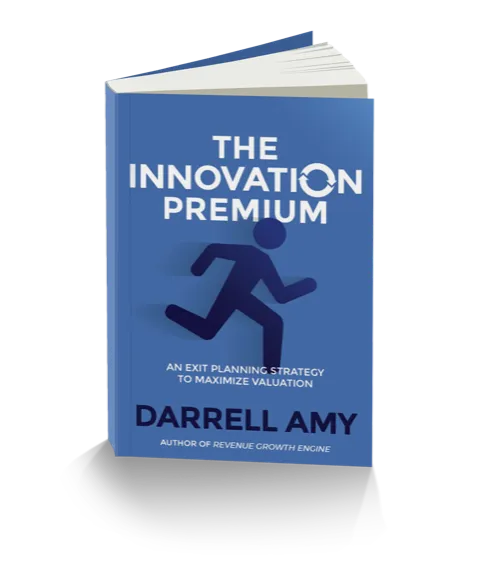THE VALUE CREATION BLOG

The Measurable Difference Between an Innovative Company vs. a Company with an Innovative Founder
“Most companies have a creative founder. The challenge, however, is to become an innovative company, rather than a company dependent on an innovative founder.” Jim Collins, Beyond Entrepreneurship 2.0
The difference between a truly innovative company and one led by an innovative founder is critical. Jim Collins highlights in Beyond Entrepreneurship 2.0 the challenge for companies to embed innovation into their culture, rather than relying on the occasional genius of their founder.
In this article, we’ll explore the three characteristics of an innovative company. We'll also look at the risks for companies that don't embrace this—potential loss in value, revenue, and market position. At the end of the article is a link to determine your company’s Innovation Index, a measure of how innovative your company really is.
Signs of an Innovative Company
In most companies, at least one of their corporate values relates to innovation. We all know talk is cheap. A truly innovative company demonstrates these three characteristics.
1. Innovation is an Ongoing Process
Every smart entrepreneur recognizes that for their company to grow they need to put structure and process in place. Yet, even in companies that have implemented business operating systems, visionary entrepreneurs are still infamous for their random acts of innovation. In his book, Innovation and Entrepreneurship, management guru, Peter Drucker, passionately advocates for innovation to become a process:
“Systematic innovation therefore consists in the purposeful and organized search for changes, and in the systematic analysis of the opportunities such changes might offer for economic or social innovation.”
2. Multiple People Are Involved
When innovation becomes a solo sport played by the founder, the company becomes vulnerable to blind spots. As we know from the game of football, blind spots can lead to getting blind-sided. Every company has multiple employees with the Working Geniuses of Wonder and Invention. These people are the perfect candidates to put on a Strategic Innovation Council. When you get the multiple perspectives of people from various functions in the organization you not only reduce blind spots, you broaden the vision to see new opportunities.
3. Innovation is Measured and Celebrated
Companies that value innovation demonstrate it by measuring and celebrating new ideas. They track the number of ideas they have successfully brought to market. They measure their Innovation Dividend, creating ways to gauge their Return on Innovation. They celebrate innovation with awards and incentives. Their offices feature an Innovation Wall that showcases new ideas that have been brought to market.
The Cost of Not Being an Innovative Company
While some companies see innovation as an unnecessary expense, others recognize the high cost of not becoming an innovative company.
1. Reduces Potential Valuation
A company with an innovative founder creates a risk for a potential buyer. “What happens to the entrepreneurial spirit when the founder leaves?” If the buyer feels like the innovative drive will leave the company, they see it as a potential reduction of future cash flows. This risk leads could lead to a discounted offer, causing millions of dollars to be left on the table. It could also lead to unfavorable terms with an earn-out as the buyer looks to hedge their risk of overpaying. Sadly, many owners leave money on the table when it comes time to exit simply because they did not take the time to become an innovative company.
2. Lowers Potential Revenue and Profits
Innovation drives growth. While a company does need consistent execution by sales, marketing, and operations to drive revenue growth, this can only get a company so far. Maximizing revenue and profits requires new ideas that capitalize on change. From new technologies like AI to shifts in your customer’s industry or business model, change is all around us. Companies that have a process to recognize changes and turn them it into opportunities realize growth in revenue and profits. Companies that don’t have a structure around innovation fail to maximize revenue and profit.
3. Puts the Company at Risk
As I read the book, The Innovation Premium, written in 1999, I was struck by one of the companies they featured as an innovation leader: Nokia. There was a time when all of us carried Nokia mobile phones. Their innovative product vaulted the company from being a nobody to $15B in revenue. However, we know the rest of the story. Their success led them to become complacent. This complacency led to disruption. As revenue increased, strategic innovation took a back seat to operational excellence.
Companies that fail to innovate take a major risk. Last week as I talked with an EOS Implementer about potential candidates for a Strategic Innovation Council, he brought up a company that was doing well. Then, he quickly said, “They are crushing it right now. I'm not sure they need innovation.”
We both smiled as we realized what was just said. The companies that are doing well need innovation more than ever. In today’s dynamic marketplace with sea-level change happening all around us, those who fail to innovate risk disruption.
How Innovative is Your Company?
Are our curious about your company stacks up? The Innovation Index is a quick assessment to determine the horsepower of your company’s innovation engine. Click here to calculate your Strategic Innovation Maturity Index.
FREE BUSINESS VALUATION
What is Your Business Worth?
You can Discover the Value of Your Business in Less than 20 Minutes!
Join 70,000 business owners and get your score on the 8 Factors That Drive Your Company’s Value, a comprehensive analysis of your score and a detailed action plan for how to improve your score on each.


PREORDER YOUR FREE COPY NOW
Discover How to Create a Premium Valuation for Your Business
Learn how to command a premium multiple on your business
Find out why buyers discount their offers
See how innovation can help you create a premium valuation
Estimate your company's innovation index



